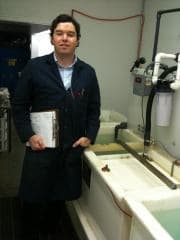
-----
Powder coating removal process
Q. I'm hoping you can answer my question. Our company is a custom metal fabricator and we have a customer's part that requires a blue powder coat finish. After the parts were completed, the customer decided that he wants a different shade of blue. My question is this: Are there any processes available that will remove the powder coating from this cold rolled steel part.
Rip Nationmachine shop - Oklahoma City, Oklahoma
2004
A. Hi Rip,
Powder coatings can be removed with hot alkali solutions or with solvent-based products.
George Gorecki- Naperville, Illinois
2004
2004
A. Mr. Nation,
Is the assumption everyone should make that you can't repaint these parts unless you remove the first coat of paint? Repainting powder is relatively easy if you have experienced operators. There are some powders that you can paint over without doing any surface prep, other powders you will have to lightly sand the surface for the second coat to adhere. Run some test panels before proceeding with this! If you have to remove the first coat because of tight tolerance issues, I'd go with someone that can do it with a fluidized, heated sand bed. When you use paint stripper, it can gunk up all of the threaded holes, and the cleanup can be a real mess. Burning it off is another suggestion that has it's drawbacks in removal of the ash and possibly changing the mechanical properties of the substrate. I've never used the hot alkali solutions, so I can't give an opinion.

Sheldon Taylor
supply chain electronics
Wake Forest, North Carolina
Q. Hello,
George Gorecki, You have suggested "Powder coatings can be removed with hot alkali solutions or with solvent-based products", but will you highlight followings :
1] The process
2] Whether any effect on surface finish, after the process is done, when the base material is Aluminum and MS ERW TUBES.
- Mumbai, Maharashtra, India
2004
A. Hi Madhav. Long immersion times in strong, hot (100 °C) caustic will strip many paints and powder coatings, and will probably not harm mild steel parts. However, they will destroy aluminum parts.
Regards,

Ted Mooney, P.E.
Striving to live Aloha
finishing.com - Pine Beach, New Jersey
Ted is available for instant help
or longer-term assistance.
A. Hi Madhav,
I don't understand your question/comment. Can you re-state?
George Gorecki- Naperville, Illinois
2004
A. The removal of powdercoated paint can be done using a process called soda blasting. The process is environmentally safe and will clean the piece of all contaminants, including powdercoated paint, down to the substrate. There is NO DAMAGE to the piece being cleaned.
A.tilano "A.J." Molinar- Rio Rancho, New Mexico, USA
2006
Q. Can you tell me what solvent can be used to remove Powder coating.
Debasish Nag- Kolkata,West Bengal, India
2006
RFQ: Hello -
I would like to have motorcycle wheels that have been powder coated, stripped of the powder coat paint, so that they can then be polished.
I have tried chemical strippers available over the counter, such as Jasco and airplane paint remover ... but the powder coating on these wheels is not touched by these chemicals.
In this thread, it is mentioned that hot alkali and/or soda blasting are effective methods to remove powder coated paint. Are there companies located in northern California, San Francisco Bay area, the offer these services?
Thanks,
- cupertino, California usa
2006
Ed. note: This RFQ is outdated, but technical replies are welcome, and readers are encouraged to post their own RFQs. But no public commercial suggestions please ( huh? why?).
A. Chemical option: Use Gasket Remover. Haven't tried it yet.
Sand Blasting is difficult on a good powder painting job and can leave a too-course surface if using a large aggregate. It will effect your final paint job if not properly prepped.
sports - Dorrance, Kansas
March 19, 2009
A. I am commenting on what Tom from KS, had mentioned about possibly utilizing Gasket Remover to remove powder coating from parts, he had not tried it yet, however was contemplating its use. Please review my comments prior to using Gasket Removers to remove powder coat.
My interest in this blog-article, describing the use of Gasket Remover for removing powder coating caught my interest, due to my own career. I have experience, formulating eco-friendly paint and powder coating removers for over 30-years.
Buyer Beware when handling and applying Gasket Removers for any application, including powder coating removal. What most people do not know without actually reviewing the Material Safety Data Sheets, Hazards Section, is that this Gasket Remover is made up primarily from a chlorinated solvent called DICHLOROMETHANE, which is suspected to cause cancer in animals as well as being toxic to your vital organs by breathing the volatile vapors during use. I believe these types of products also contain Hazardous Air Pollutants, which is not friendly to the atmosphere that we all breathe and share.
Past paint stripping technologies were based on this same chlorinated solvent, synonymously called Methylene Chloride. This is a chemical that I personally would stay away from utilizing to remove paint and powder coating, with all the safer alternatives available today.
There is good news, eco-friendly, Green type stripping solutions for stripping paint, varnish removers and to remove powder coating are available.
Best regards, Sam
Kissimmee, Florida
May 9, 2009
Q. Planning to use gasket remover to strip powder coated handlebars for chrome plating. Will this cause any problems for chrome plating?
Brad de Leon- Toronto, Ontario
December 3, 2012
A. Hi Brad. As Sam notes, methylene chloride is horribly toxic. But its strong suit is that it tends to not damage metal at all.
Regards,

Ted Mooney, P.E.
Striving to live Aloha
finishing.com - Pine Beach, New Jersey
Ted is available for instant help
or longer-term assistance.
Q. Can anyone tell me how to remove the powder coating from the copper tube? I had tried thinner, wire brush and sandpaper but nothing worked properly. Please suggest to me an effective method to remove the powder coating.
Parag Pemgirikar- Pune, Maharashtra, India
March 30, 2013
A. Hi Parag. We appreciate that you have tried several things, but hot caustic, fluidized sand bed, soda blasting, methylene chloride, and environmentally-friendly proprietary strippers have been suggested. Do you have any comments from having used them, or questions about the suggestions? I'm pretty confident that methylene chloride will not harm the copper, although it can hurt you if not used with care. Thanks.
Regards,

Ted Mooney, P.E.
Striving to live Aloha
finishing.com - Pine Beach, New Jersey
Ted is available for instant help
or longer-term assistance.
Q. Hi everyone, I work on a paint line that uses powder coating for 90% of our product. When paint goes wrong we usually put them in a burn-off oven for 3 hours at 1200 degrees. That usually does the trick.
But lately we cannot keep up, the oven takes too long. I heard that there's a machine out there that uses hot sand to strip away the paint ... does anyone know what is it called? Or if that machine even exists?
Rafa
- Hartford, Wisconsin
March 26, 2014
A. There is a hot sand machine that originally was developed in Europe. We do not use it at my company because it leaves sand particles all over the place resulting in many rejects from the repaint process. We use a LARGE burn off oven, an alkaline process, and an acid process depending on the base material and special features.
Joel Cheek- Fairburn, Georgia USA
May 5, 2014
May 6, 2014
A. I wonder if you are looking at the real problem?
Why is it necessary to strip so many rejects?
Is there a fundamental problem with your coating process?
There are certainly sand ovens and chemical means to remove coatings from various substrates.
Would it not be better to fix the real problem rather than accelerate reject repairs?
Let's hear more about what the reject rate is and the basis for rejection.
Regards,
Bill
Trainer - Newcastle NSW Australia
How to remove black paint on fasteners from China
Q. I am currently facing a lot of issues with surface preparation, especially for fasteners that are blackened from China.
I run an electroplating company and in the recent past I have observed that fasteners that are procured from China have a hard black paint on it which is very difficult to remove specially in "nut threads". I have tried to remove it by soaking it in Caustic H20 solution at 100 °C heat for hours and then pickling .. however its very difficult to get a clean surface for electroplating ...
Can anyone advise how can I best do it? It has wasted a lot of my production hours and chemicals!
Please help
Electro plater - dubai, UAE
February 23, 2015
A. First, what is the material under the the black paint you are stripping? If the materiel was strong enough to withstand a glass blast I would suggest you pick up a blaster. However, if the material is soft this will certainly damage the thread pattern possibly even wiping it out completely. Assuming it is steel or stronger, a fine glass blast then light polish seems like it would do the trick. Being that China doesn't have the type of regulation on what is in paints, it's hard for me to say what will best strip it. Any methylene chloride based strip would work better then the caustic H20 if it is truly just paint. The best answer I could think of would be to contact the company that makes the part in China and order them raw and unpainted. Good luck.

Chance Dunstan
Electroplating/Forming/Coating Manager
Placerville, California USA
April 1, 2015
March 2015
![]() Hi. Can't help agreeing with Chance's closing suggestion. It seems close to ridiculous that fasteners which are intended to be plated are first covered with a tenacious, impervious coating that makes proper plating so problematic :-)
Hi. Can't help agreeing with Chance's closing suggestion. It seems close to ridiculous that fasteners which are intended to be plated are first covered with a tenacious, impervious coating that makes proper plating so problematic :-)
Regards,

Ted Mooney, P.E.
Striving to live Aloha
finishing.com - Pine Beach, New Jersey
Ted is available for instant help
or longer-term assistance.
Q, A, or Comment on THIS thread -or- Start a NEW Thread